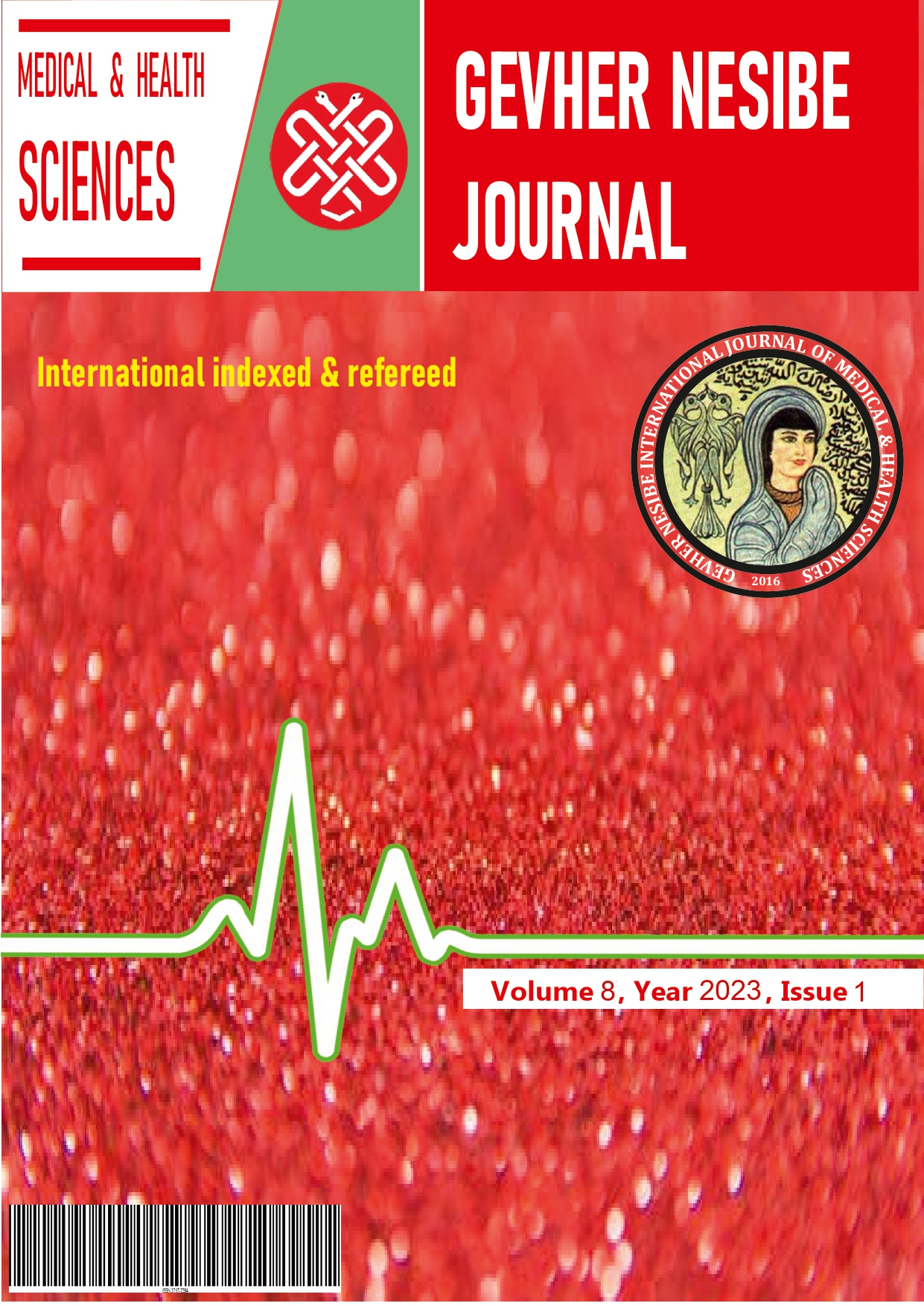Turkish Validity-Reliability Study Of The COVID-19 Preventive Behaviors Index
DOI:
https://doi.org/10.5281/zenodo.7600693Keywords:
COVID-19 fear, , COVID-19 Preventive Behaviors Index, Reliability, ValidityAbstract
Aim: In this study, it is aimed to adapt the Covid-19 Preventive Behaviors Index (CPBI) into Turkish and analyze its validity and reliability.
Method: The study is descriptive, correlational, and methodological design. Research data were collected online from 236 people aged 18 and over living in Turkey. SPSS v.26.0 and AMOS v.26.0 package programs were used in the analysis of the research data. Language equivalence, content validity, construct validity, internal consistency, item-total correlations, test-retest reliability, 27% lower-upper group item comparisons and criterion-dependent validity of CPBI was examined.
Results: As a result of the exploratory factor analysis, it was determined that 8 items in the index were collected in a single factor and explained 47,234% of the total variance. As a result of the confirmatory factor analysis, it was seen that the one-dimensional structure of the index consisting of 8 items had acceptable fit index values. The Cronbach's Alpha coefficient of the index is 0.833 and has a high level of reliability. In addition, the item-total correlations of the index ranged from 0.466 to 0.747, and a significant difference was found in the 27% lower and upper groups in the averages of the items in the index.
Conclusion: Our study showed that the 8-item, one-dimensional CODI is a valid and reliable index to measure the probability of individuals to engage in Covid-19 preventive behaviors.
References
Ahorsu, D. K., Lin, C. Y., Imani, V., Saffari, M., Griffiths, M. D., & Pakpour, A. H. (2020). The Fear of COVID-19 Scale: Development and Initial Validation. International Journal of Mental Health and Addiction. https://doi.org/10.1007/s11469-020-00270-8
Akgül, A. (2005). Faktör analizi. Tıbbi araştırmalarda istatistiksel analiz teknikleri SPSS uygulamaları (2. baskı). Emek Ofset.
Altunışık, R., Coşkun, R., Bayraktaroğlu, S., & Yıldırım, E. (2012). Sosyal Bilimlerde Araştırma yöntemler (SPSS Uygulamalı) (7. Baskı). Sakarya Yayıncılık.
Beaton, D. E., Bombardier, C., Guillemin, F., & Ferraz, M. B. (2000). Guidelines for the process of cross-cultural adaptation of self-report measures. In Spine (Vol. 25, Issue 24). https://doi.org/10.1097/00007632-200012150-00014
Breakwell, G. M., Fino, E., & Jaspal, R. (2021). The COVID-19 Preventive Behaviors Index: Development and Validation in Two Samples From the United Kingdom. Evaluation and the Health Professions, 44(1), 77–86. https://doi.org/10.1177/0163278720983416
Büyüköztürk, Ş. (2010). İstatistik, Araştırma Deseni SPSS Uygulamaları ve Yorum. In Ş. Büyüköztürk (Ed.), Sosyal Bilimler için Veri Analizi El Kitabı (11th ed.). Pegem A Yayıncılık.
Çapık, C., Gözüm, S., & Aksayan, S. (2018). Intercultural Scale Adaptation Stages, Language and Culture Adaptation: Updated Guideline. Florence Nightingale Hemşirelik Dergisi, 26(3), 199–210. https://doi.org/10.26650/fnjn397481
CDC. (2019). Centers for Disease Control and Prevention - Coronavirus Disease 2019 (COVID-19). Centers for Disease Control and Prevention.
Desai, A. N., & Aronoff, D. M. (2020). Masks and Coronavirus Disease 2019 (COVID-19). JAMA - Journal of the American Medical Association, 323(20), 2103. https://doi.org/10.1001/jama.2020.6437
DeVellis, R. F. (2012). Scale Development : Theory and Applications. (3rd ed.). Sage Publisher.
Eikenberry, S. E., Mancuso, M., Iboi, E., Phan, T., Eikenberry, K., Kuang, Y., Kostelich, E., & Gumel, A. B. (2020). To mask or not to mask: Modeling the potential for face mask use by the general public to curtail the COVID-19 pandemic. Infectious Disease Modelling, 5, 293–308. https://doi.org/10.1016/j.idm.2020.04.001
Firouzbakht, M., Omidvar, S., Firouzbakht, S., & Asadi-Amoli, A. (2021). COVID-19 preventive behaviors and influencing factors in the Iranian population; a web-based survey. BMC Public Health, 21(1), 143. https://doi.org/10.1186/s12889-021-10201-4
Hayran, M., & Hayran, M. (2011). Basic Istatistics for Health Surveys (Art Ofset Publication, Ed.; 1st. editi).
Jamaludin, S., Azmir, N. A., Mohamad Ayob, A. F., & Zainal, N. (2020). COVID-19 exit strategy: Transitioning towards a new normal. Annals of Medicine and Surgery, 59(October), 165–170. https://doi.org/10.1016/j.amsu.2020.09.046
Johnson, R. B. & Christensen, L. B. (2007). Educational research: Quantitative, Qualitative, and Mixed Approaches, 3rd ed.,. In Sage, Thousand Oaks (US) (3rd ed.). Sage Publication.
Kayış, A. (2016). Güvenirlik Analizleri. In Ş. Kalaycı (Ed.), SPSS Uygulamalı Çok Değişkenli İstatistik Teknikleri (7th ed., pp. 403–419). Asil Yayın Dağıtım.
Kowalski, R. M., & Black, K. J. (2021). Protection Motivation and the COVID-19 Virus. Health Communication, 36(1), 15–22. https://doi.org/10.1080/10410236.2020.1847448
Özdamar, K. (2013). Medikal Testlerin Değerlendirilmesi ve ROC Eğrisi Analizi. In SPSS ile Biyoistatistik (9. Baskı, pp. 421–436). Nisan Kitapevi.
Özdamar, K. (2016). Eğitim, Sağlık ve Davranış Bilimlerinde Ölçek ve Test Geliştirme Yapısal Eşitlik Modellemesi IBM SPSS, IBM SPSS AMOS ve MINITAB Uygulamalı (1. Baskı). Nisan Kitapevi.
Polit, D. F., Beck, C. T., & Owen, S. V. (2007). Focus on research methods: Is the CVI an acceptable indicator of content validity? Appraisal and recommendations. Research in Nursing and Health, 30(4), 459–467. https://doi.org/10.1002/nur.20199
Sağlık Bakanlığı. (2022). Türkiye COVID-19 Hasta Tablosu. COVID-19 Bilgilendirme Platformu. https://covid19.saglik.gov.tr/.
Satici, B., Gocet-Tekin, E., Deniz, M. E., & Satici, S. A. (2020). Adaptation of the Fear of COVID-19 Scale: Its Association with Psychological Distress and Life Satisfaction in Turkey. International Journal of Mental Health and Addiction. https://doi.org/10.1007/s11469-020-00294-0
Schermelleh-Engel, K., Moosbrugger, H., & Müller, H. (2003). Evaluating the fit of structural equation models: Tests of significance and descriptive goodness-of-fit measures. MPR-Online, 8(May 2003), 23–74.
Terwee, C. B., Bot, S. D. M., de Boer, M. R., van der Windt, D. A. W. M., Knol, D. L., Dekker, J., Bouter, L. M., & de Vet, H. C. W. (2007). Quality criteria were proposed for measurement properties of health status questionnaires. Journal of Clinical Epidemiology, 60(1). https://doi.org/10.1016/j.jclinepi.2006.03.012
Veneziano, L., & Hooper, J. (1997). A Method for Quantifying Content Validity of Health-Related Questionnaires. American Journal of Health Behavior, 21(1), 67–70.
Wheaton, B., Muthen, B., Alwin, D. F., & Summers, G. F. (1977). Assessing Reliability and Stability in Panel Models. Sociological Methodology, 8(May), 84. https://doi.org/10.2307/270754
WHO. (2022). WHO Coronavirus (COVİD-19) Dashboard. https://covid19.who.int
Yong, A. G., & Pearce, S. (2013). A Beginner’s Guide to Factor Analysis: Focusing on Exploratory Factor Analysis. Tutorials in Quantitative Methods for Psychology, 9(2), 79–94. https://doi.org/10.20982/tqmp.09.2.p079
Downloads
Published
How to Cite
Issue
Section
License
Copyright (c) 2023 GEVHER NESIBE JOURNAL OF MEDICAL AND HEALTH SCIENCES

This work is licensed under a Creative Commons Attribution-NonCommercial 4.0 International License.


